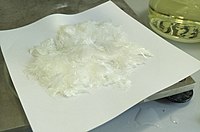
Photo from wikipedia
Abstract The sodium form of industrial X-zeolite (13X) was compared with two other samples obtained by a partial (about 70%) cation exchange with Mg2+ (Mg-X) or a complete exchange with… Click to show full abstract
Abstract The sodium form of industrial X-zeolite (13X) was compared with two other samples obtained by a partial (about 70%) cation exchange with Mg2+ (Mg-X) or a complete exchange with Ca2+ (Ca-X) in view of their use as adsorbents for water vapor in energy storage systems by sorption. Various sorption methods based on the specific interactions between two probing molecules (N2 and NH3) and specific surface sites were employed to monitor the hydration state of the zeolite surface as a function of the temperature of sample drying performed under vacuum degassing or gas-flow conditions. X-ray diffraction, volumetric sorption technique, temperature-programmed desorption, and gas flow calorimetry were combined with Monte Carlo simulations of the mechanism of water vapor adsorption on model zeolites to demonstrate that the general tendency to operate under mild drying conditions would always result in a state of partial hydration of the zeolite surface. To increase the amount of heat released upon subsequent adsorption from a flow of helium at a relative pressure of water vapor of about 0.03, the use of Mg-X sample was demonstrated the best alternative if the activation procedure was to be performed at 200 °C. Here, the heat effect was 4–5 times greater than that measured in the case of 13X. This result is of high importance for the industrial-scale implementation of the energy storage by sorption.
Journal Title: Solar Energy Materials and Solar Cells
Year Published: 2017
Link to full text (if available)
Share on Social Media: Sign Up to like & get
recommendations!